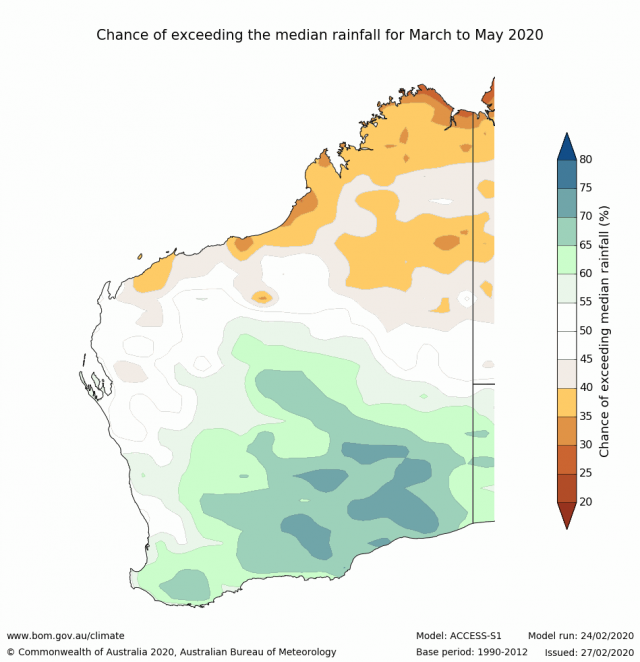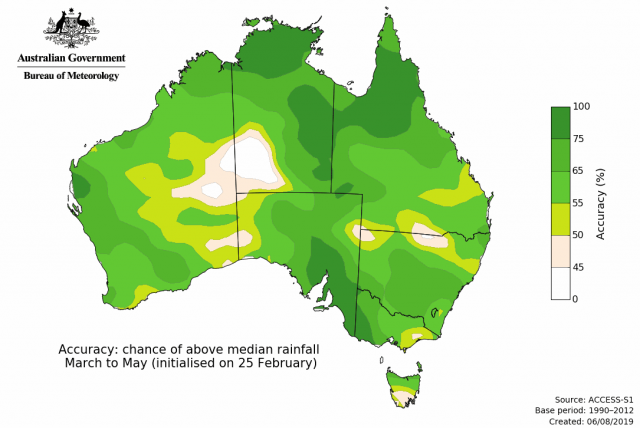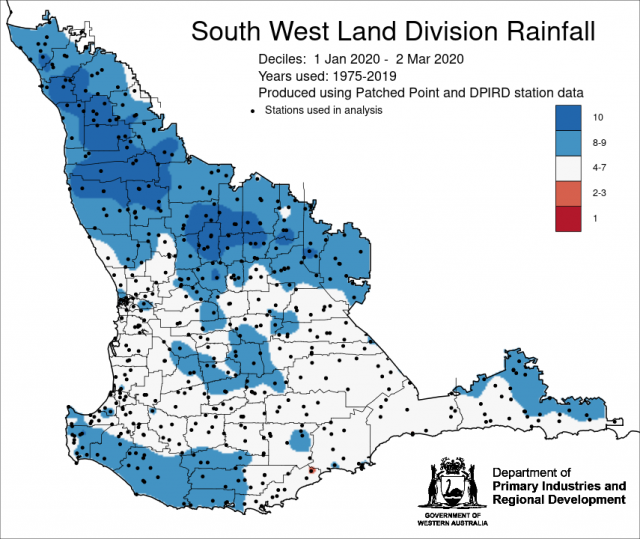Summary
The Department of Primary Industries and Regional Development’s (DPIRD) Statistical Seasonal Forecast (SSF) outlook for autumn, March to May 2020 is indicating less than 40% probability of above median rainfall in the north and greater than 60% chance in the south of the South West Land Division (SWLD).
- For autumn, March to May 2020, the SSF is indicating less than 40% chance of exceeding median rainfall for parts of the Central West District with higher chances (greater than 60%) for parts of the South West, Great Southern, South Coastal and South East Coastal Districts. Neutral chances (40-60%) for other areas of the South West Land Division. The most probable rainfall decile map indicates decile 2-3 for parts of the Central West and Central Wheatbelt Districts and decile 8-10 for parts of the Great Southern, South Coastal and South East Coastal. Predictive skill based on February conditions is poor to good (50 -75% consistent).
- The Bureau of Meteorology’s current seasonal outlook is indicating 45-75% chance of exceeding median rainfall for autumn, March to May 2020. Predictive skill is poor to good (50-75% consistent). The longer-term outlook for April to June is also 45-75% chance, with the higher chances for eastern grainbelt.
- Temperature outlooks for autumn, March to May 2020, from the Bureau indicate a 35-55% chance of above average day-time maxima (skill 45-65%) and 75-80% chance of above average night-time minima (skill 50-65%) for the SWLD.
- February rainfall was above average for the majority of the SWLD due to ex-tropical cyclone Damien and a period of sustained thunderstorns late in the month.February maximum temperatures were average to above average and minimum temperatures were very much above average.
- Indian Ocean sea surface temperatures (SST) off the WA coastline have been warmer than average. Warmer waters surrounding northern Australia are also likely, which would typically increase the chance of wetter conditions in southern and eastern Australia.
Three Month Outlook for the south-west of Western Australia
Statistical Seasonal Forecasting (SSF)
DPIRD’s Statistical Seasonal Forecast (SSF) system uses historical relationships between global sea surface temperature and sea level pressure with rainfall in south-west Australia to produce forecasts of rainfall for the coming months. Users can click on any station indicated on the map for location-specific forecast information from the Seasonal Climate Information web page.
For autumn, March to May 2020, the SSF is indicating less than 40% chance of exceeding median rainfall for parts of the Central West District with higher chances (greater than 60%) for parts of the South West, Great Southern, South Coastal and South East Coastal Districts. Neutral chances (40-60%) for other areas of the South West Land Division. The most probable rainfall decile map indicates decile 2-3 for parts of the Central West and Central Wheatbelt Districts and decile 8-10 for parts of the Great Southern, South Coastal and South East Coastal. Predictive skill based on February conditions is poor to good (50 -75% consistent).
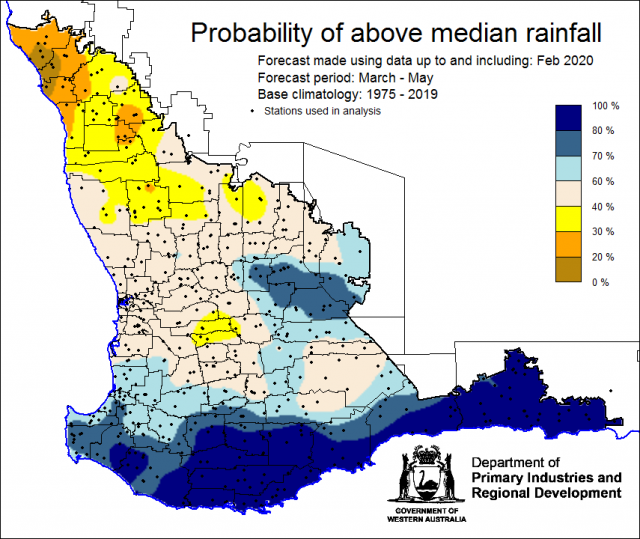
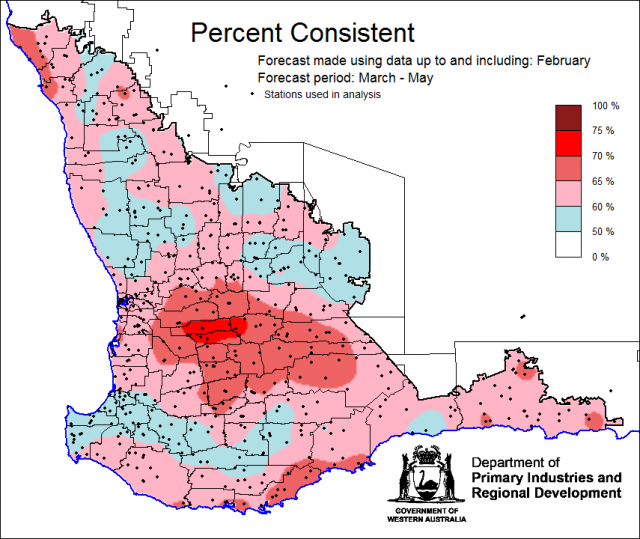
Bureau of Meteorology seasonal climate outlook
The Bureau of Meteorology's climate forecast system for monthly and seasonal climate outlooks is the Australian Community Climate Earth-System Simulator – Seasonal (ACCESS–S). It is a dynamical (physics-based) forecast modelling system and is a collaboration between the Bureau of Meteorology and the UK Meteorological Office.
The Bureau of Meteorology’s current seasonal outlook is indicating 45-75% chance of exceeding median rainfall for autumn, March to May 2020. Similar to the SSF, highest probabilities are for the South Coast. Predictive skill is poor to good (50-75% consistent). The longer-term outlook for April to June is also 45-75% chance, higher chances for eastern grainbelt.
Temperature outlooks for autumn, March to May 2020, from the Bureau indicate a 35-55% chance of above average day-time maxima (skill 45-65%) and 75-80% chance of above average night-time minima (skill 50-65%) for the SWLD.
Recent climate
February rainfall was above average for the majority of the SWLD due to ex-tropical cyclone Damien and a period of sustained thunderstorms late in the month.February maximum were average to above average and minimum temperatures were very much above average. Rainfall from 1 January to date has been above average in Central West, parts of the Central Wheatbelt, South West and South Coastal Districts of the SWLD.
In February, the atmospheric pressure was slightly above normal over the SWLD.
Indian Ocean sea surface temperatures (SST) off the WA coastline have been warmer than average. Warmer waters surrounding northern Australia are also likely, which would typically increase the chance of wetter conditions in southern and eastern Australia. The March to May 2020, SST forecast by the Bureau of Meteorology indicates SSTs are likely to remain warm north of WA.
The Southern Annular Mode (SAM), also known as the Antarctic Oscillation (AAO), describes the north–south movement of the westerly wind belt that circles Antarctica, dominating the middle to higher latitudes of the southern hemisphere. SAM is currently neutral and likely to remain neutral over the coming few weeks.
The Indian Ocean Dipole (IOD) and the El Niño–Southern Oscillation (ENSO) are currently neutral and are likely to remain neutral through the southern autumn. For further information, see the Bureau of Meteorology’s ENSO Wrap Up.
The table below gives a summary of past month and three-month South West Land Division (SWLD) climate conditions, and can indicate what is likely to occur in the near future if climate conditions follow the current pattern.
| Climate Indicator | Past month | Past Three months |
|---|---|---|
| SWLD Rainfall | Above average | Above average to average |
| SWLD Mean Temperature | Above average | Very much above average |
| SWLD atmospheric pressure | Above Normal | Above Normal |
| Indian Ocean Sea surface temperature | Warmer | Warmer |
| El Niño/Southern Oscillation (ENSO) | Neutral | Neutral |
| Indian Ocean Dipole (IOD) | Neutral | Neutral |
| Southern Annular Mode (SAM) | Neutral | Neutral |

